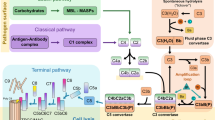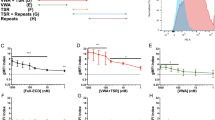Abstract
Successful invasion of mammalian cells by pathogenic parasites is generally considered, from circumstantial evidence, to be a consequence of specific mechanisms of recognition of cell surface components1–3—this has stimulated investigations of the biochemical characterization of such molecules4–6. Several studies of trypanosomiasis have examined the ability of parasites to interact with mammalian cells7,8. However, knowledge of the mammalian cell surface ‘receptors’ which interact with the parasite is limited. We now report that fibronectin, which is a high molecular weight glycoprotein present in blood, connective tissue and at cell surfaces9, binds specifically to Trypanosoma cruzi trypomastigotes. The reaction is specific, reversible (in the presence of a 100-fold molar excess of unlabelled ligand) and of moderate affinity (Kd = 11.36 nM). Various other proteins (for example, thyroglobulin, ferritin, catalase, aldolase, human IgG and bovine serum albumin) had no significant effect on the binding of labelled ligand to the parasite surface. Addition of anti-fibronectin antibodies to the culture medium significantly inhibited the infection of rat fibroblasts (3T3 FR) by T. cruzi trypomastigotes, suggesting that cell surface fibronectin may act as a recognition site for attachment of the parasites.
This is a preview of subscription content, access via your institution
Access options
Subscribe to this journal
Receive 51 print issues and online access
$199.00 per year
only $3.90 per issue
Buy this article
- Purchase on Springer Link
- Instant access to full article PDF
Prices may be subject to local taxes which are calculated during checkout
Similar content being viewed by others
References
Sherman, I. W. Microbiol. Rev. 43, 453–495 (1979).
Chapman, W. E. & Ward, P. A. Science 196, 67–69 (1977).
Annable, C. R. Fed. Proc. 31 (Abstr.), 2480 (1972).
Miller, L. H., Dvorak, J. A., Shiroishi, T. & Durocher, J. R. J. exp. Med. 138, 1597–1601 (1973).
Chapman, W. E. & Ward, P. A. J. Immun. 116, 1284–1288 (1976).
Jack, R. M. & Ward, P. A. J. Immun. 124, 1566–1573 (1980).
Brener, Z. A. Rev. Microbiol. 27, 343–382 (1973).
Dvorak, J. A. in Proc. Symp. on New Approaches in American Trypanosomiasis Research 109–120 (Pan American Health Organization, 1976).
Hynes, R. O. & Yamada, K. M. J. Cell Biol. 95, 369–377 (1982).
Beachey, E. H. & Simpson, W. A. Infection 10, 107 (1982).
Pearlstein, E., Gold, L. L. & Garcia-Pardo, A. Molec. cell. Biochem. 29, 103–128 (1980).
Ofek, I. & Beachey, E. H. in Bacterial Adherence (Beachey, E. H. ed.) 1 (Chapman & Hall, 1980).
Henriquez, D., Piras, R. & Piras, M. M. Molec. Biochem. Parasit. 2, 359–366 (1981).
Andrews, N. W. & Colli, W. 8th A. Meet. on Basic Research on Chagas' Disease, Caxambu, Brazil, Abstr. 104 (1981).
St Mark, J. C. & Dvorak, J. A. Molec. Biochem. Parasit. 5, 333–341 (1982).
Santiago, A. R., Afchain, D. & Capron, A. Annls Soc. belge Med. trop. 61, 369–377 (1981).
Scatchard, G. Ann. N.Y. Acad. Sci. 51, 660–663 (1949).
Ruoslahti, E., Vuento, M. & Engvall, E. Biochim. biophys. Acta 534, 210–218 (1978).
McConahey, P. J. & Dixon, F. J. Int. Archs Allergy appl. Immun. 29, 185 (1966).
Afchain, D., Le Ray, D., Fruit, J. & Capron, A. J. Parasit. 65, 507–514 (1979).
Ouaissi, M. A., Cornette, J. & Capron, A. Parasitology, 88, 85–96 (1984).
Towbin, H., Staehelin, T. & Gordon, J. Proc. natn. Acad. Sci. U.S.A. 76, 4350–4354 (1979).
Carter, W. G., Fukuda, M., Lingwood, C. & Hakomori, S. Ann. N.Y. Acad. Sci. 312, 160–177 (1978).
Author information
Authors and Affiliations
Rights and permissions
About this article
Cite this article
Ouaissi, M., Afchain, D., Capron, A. et al. Fibronectin receptors on Trypanosoma cruzi trypomastigotes and their biological function. Nature 308, 380–382 (1984). https://doi.org/10.1038/308380a0
Received:
Accepted:
Issue Date:
DOI: https://doi.org/10.1038/308380a0
This article is cited by
-
Identification of candidate mimicry proteins involved in parasite-driven phenotypic changes
Parasites & Vectors (2015)
-
Prokineticin receptor identified by phage display is an entry receptor for Trypanosoma cruzi into mammalian cells
Parasitology Research (2015)
-
Biopanning and rapid analysis of selective interactive ligands
Nature Medicine (2001)
-
Purification of collagen-binding proteins ofLactobacillus reuteri NCIB 11951
Current Microbiology (1994)
Comments
By submitting a comment you agree to abide by our Terms and Community Guidelines. If you find something abusive or that does not comply with our terms or guidelines please flag it as inappropriate.



